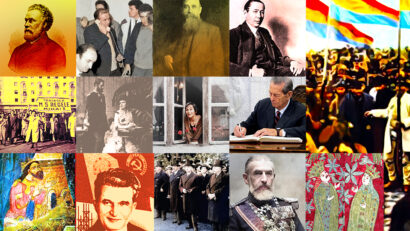Epidemics on Romanian Territories
Historians are unanimous in describing epidemics as a strong factor influencing human civilization.

Steliu Lambru, 26.10.2015, 13:26
Historians
are unanimous in describing epidemics as a strong factor influencing human
civilization just like any other major
event. The epidemics that had the strongest impact were those of plague,
smallpox and cholera. The plague, also called ‘the black death’, known in the
Romanian Principalities as the black ulcer, has killed the biggest number of
people throughout history. According to some historians, the great plague epidemic
of the mid 17th century left around
75 million people dead. It was not until late 19th century,
in 1894 , that the French Alexandre Yersin discovered the bacteria causing the
pest, and with it the remedy against the most terrible disease ever. Before Yersin’
s great discovery, the only cure against the plague was the ‘survival of the
fittest’, which meant that the only people who could save their lives were
those immune to the bacteria or those developing a less serious form of the
disease.
The Romanian
territories were also hit by epidemics that had a strong impact on how people
viewed the world. Professor Octavian Buda, currently teaching the history of
medicine at the Carol Davila Medicine and Pharmacy University in Bucharest,
spoke about plague in the 15th century on Romanian territory,
actually a follow-up to the great plague epidemic in the previous century.
Octavian Buda: There is a series of
accounts provided by foreign physicians who were employed by various courts of
that time, like those of Stephen the Great, Matei Basarab or Vasile Lupu. The
big problem is to identify the clinical picture, since the meaning of the
generic word ulcer, for instance, was rather broad. In demotic parlance,
ulcer means disease, precisely. And then it is something rather hard to
define. We do not have specific information on Iancu of Hunedoara’s case. Most
likely, it was linked to the theatre of operations in the south. One of the
extensions of the latest plague epidemics in Western Europe occurred through the
Dalmatian ports of Dubrovnik or Ragusa. The Romanian medicine historian,
Nicolae Vatamanu, has even come up with an unusual idea, but based on evidence,
namely that in the famous battle of Razboieni, known to have been won by the
Ottoman Sultan Muhammad the 2nd, against Stephen the Great, which
was a Pyrrhic victory, an episode of a pest coming from Urals and Crimea
interfered. It is a take on the event which deserves to be examined very
carefully.
Plague
epidemics occurred periodically in the next centuries. The 1666 London plague
epidemic was horrendous, although of a smaller-scale than the previous ones. In
the Romanian Principalities, the 18th century saw the beginning of
the Phanariot rule, and the first Phanariot ruler, Nicolae Mavrocordat, was
killed by the plague in 1730. But the epidemic with the highest impact started
in the period 1813-1814 during Caragea’s rule, being called Caragea’s plague.
Thus the Phanariot rule was metaphorically considered ominous in Romania’s
history, given that it started and ended with a plague epidemic. Octavian Buda
talked about the measures taken by the Wallachian authorities and the methods
used to fight the epidemic.
Octavian Buda: Quarantine
measures were taken down the Danube River up to Bucharest, slum bailiffs were designated
and the number of gravediggers was increased. They were assigned to take care
of corpses and to administer the places where the victims were buried. The
gravedigger’s guild became very active and they earned very high salaries.
Their job was to gather the corpses and bury them. Gravediggers
were recruited from among the people who were infected with the plague bacteria
and had survived the infection, this being considered a very good anti-epidemic
measure. It seems that the then rulers empirically became aware of the fact
that the survivors of the plague had acquired some immunity. Historian Ion
Ghica referred to the gravediggers in very negative terms. When they passed by
the houses of rich people they tore rags from the plague-infected people to
spread the infection. Even if they risked the death penalty, they killed the
plague-infected people in the street or buried them alive to no longer take the
pain to transport them to hospital. An interesting story is found in the report
of a gravedigger: ‘today I gathered around 15 corpses which I loaded in the
cart from the Dudesti plain, but I reached the destination with only 14 corpses
as one of them suddenly stood up and ran for his life’.
The
people’s desperation could not be contained either by priests or by healers.
They found relief in alcohol, the best friend of dismayed people. Octavian
Buda: Given
the lack of efficient treatments, alcohol consumed in large quantities helped
people appease their angst. But restrictions were introduced in this respect
too. There were healers who promised the plague-infected people healing if they
touched a turtle. There was a hospital for treating the plague in Bucharest, in
Dudesti, and there was also the Saint Vissarion hospital where a lazaretto was
set up after the Venetian model, where plague-infected people were confined.
The extreme
frost of the winter of 1813-1814 abated the peak of the contagion but did not
eradicate the disease. According to reports by the Austrian consul to Bucharest
Fleischak von Hackenau, as many as 4,500 people died during Caragea’s plague.
The plague was called Caragea’s Plague because it was brought by a person in
the entourage of the prince who was eager to come to Bucharest to take power.
This plague put an end to an epoch, ushering in the modern age.





























